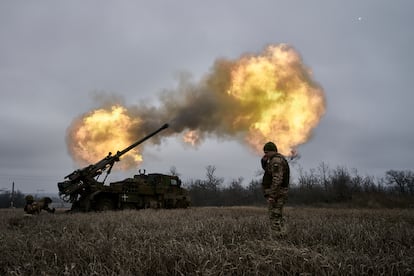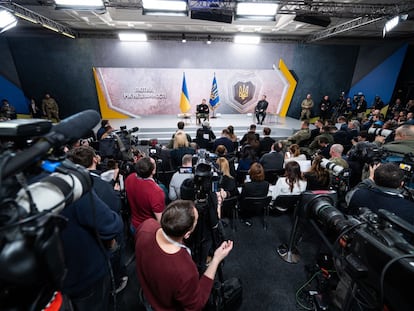Russia reinforces with new Iranian and North Korean weapons, while Ukraine calls for green light to strike Russian soil
Kyiv is growing impatient over Washington’s ban on long-range missile attacks on targets far from the Russia’s border

Not a day goes by when Volodymyr Zelenskiy and his government do not publicly and privately pressure Joe Biden to give Ukraine the green light to use NATO’s long-range missiles to strike targets on Russian soil. While the Ukrainian leader tries to convince the U.S. president to cross this red line, Moscow has reinforced its offensive with weapons supplied by North Korea and Iran.
Kyrylo Budanov, the head of the Ukrainian Defense Ministry’s intelligence services, said Saturday that new deliveries of North Korean artillery shells to Russian troops are helping the invader’s advance on multiple fronts in Donetsk province. “They supply huge amounts of artillery ammunition, which is critical for Russia,” Budanov said at a press conference in Kyiv. The intelligence chief added that North Korea is also supplying ballistic missiles, but in smaller volumes. “Out of all of Russia’s allies, our biggest problem is North Korea because of the volume of military supplies they are providing, which truly affects the intensity of the fighting,” Budanov said. “Unfortunately, we cannot do anything about it at the moment.”
North Korea has vast quantities of Soviet-made artillery ammunition, including the weapons used by Russia. Russian President Vladimir Putin and North Korean leader Kim Jong-un strengthened bilateral trade and military ties this year. Sergei Shoigu, the head of Russia’s Security Council, visited Kim in Pyongyang last week, and on Tuesday, Russian Foreign Minister Sergey Lavrov met with his visiting North Korean counterpart, Choe Son-hui.
Budanov was also referring to North Korean Hwasong-11 ballistic missiles identified in the Russian arsenal. Four of these missiles were identified in the August 18 bombing raid on Kyiv. Remnants of these missiles have been found on previous occasions, but in the case of the August 18 bombing, the weapons had been manufactured this year, according to The New York Times. The Hwasong-11 is a long-range missile with a flight range of around 450 miles.
With respect to shorter-range missiles, the United States, the United Kingdom and the European Commission believe that Tehran delivered the Iranian-made Fath-360 — which has a range of 75 miles — to Moscow in September. Sky News reported that Russia may have received more than 200 Fath-360s. Both the Kremlin and Iran have denied this. So far, there are no reports that these missiles have been fired on Ukrainian soil. Ukrainian defense experts argue that Russia could use the Faths to strike targets close to the front from Russian soil.
In addition to the alleged deliveries of the Fath-360s, Iran has provided Russia with its Shahed bomb drones, which have been used extensively in Russia’s war against Ukraine. The Russian military now uses several adaptations of the Shaheds produced by its own forces. On Tuesday, Shoigu met with Iranian President Masoud Pezeshkian, and according to state media, the Iranian leader told him that relations between Tehran and Moscow would develop in a “continuous and lasting way.”
Supply problems
Russia’s alliance with Iran and North Korea comes as Ukraine struggles with a shortfall of Western weapons. Zelenskiy told CNN on Sunday that they were expecting supplies to rearm 14 brigades, but have barely enough to rearm four. The Ukrainian stressed that the country must increasingly rely on strengthening its own weapons production, particularly drones.
It was Zelenskiy himself who announced in August that a new Ukrainian-made ballistic missile and a missile-drone had been successfully tested. In 2023, Ukraine’s Ministry of Defense launched an adaptation of the Neptune anti-ship missile to hit land targets. Ukrainian authorities themselves admitted that the production capacity of these rockets was limited due to the lack of resources and the risk of a Russian attack.
Zelenskiy’s military industry adviser, Oleksandr Kamyshin, told AFP on September 14 that Ukraine needs $20 billion to operate at full capacity, but that only $7 billion is available in the state budget. Danish Defense Minister Troels Lund also said this weekend that 18 Ukrainian-made Bogdan howitzers had entered service in the past two months thanks to funding from his government.
Long-range missiles
But for Zelenskiy, the top priority is getting Biden’s approval to use NATO long-range missiles against military targets inside Russia. Washington has so far allowed its war technology to be used in border regions, including in the Ukrainian incursion into Kursk province, but the U.S. president is still weighing up his decision. Opinions within his administration are divided, according to reports in the main U.S. media. Putin has warned that striking Russian territory far from the front with NATO weapons would be a declaration of war.
The Ukrainian president raised the issue again on Sunday after four precision-guided aerial bombs fell on civilian areas in the city of Kharkiv. The Ukrainian government and military insist they must be able to destroy Russian aircraft firing on their country from hundreds of miles away. “Every Russian strike of this nature, every instance of Russian terror [...] proves that there must be long-range capability and it must be sufficient,” Zelenskiy said in a video message released on Sunday. “We are waiting for the relevant decisions, especially from the United States, the United Kingdom, France, Germany, Italy — everyone whose decisiveness can help save lives.”
Zelenskiy even hinted at a conference on September 13 that the future of the war depends on this decision: “We need enough long-range missiles to change the course of the war and force Russia to negotiate peace.” The Ukrainian leader believes that an arsenal of long-range missiles could act as a deterrent to push Russia to withdraw from the occupied territories in Ukraine.
The British government has signalled that it is in favor of allowing Ukraine to fire its Storm Shadow missiles against targets in Russia, although it is awaiting a decision from Washington. Italian Prime Minister Giorgia Meloni on Monday expressed her support for giving the green light to Ukraine’s request at a press conference with British Prime Minister Keir Starmer. Italy has supplied Storm Shadow units to Kyiv. France — which is involved in producing and delivering Scalp missiles, a variant of the Storm Shadow, to Ukraine — has avoided taking a position. German Chancellor Olaf Scholz has made it clear that he will not deliver Germany’s Taurus long-range missiles and that under no circumstances does he want German weapons to be used on Russian soil.
Sign up for our weekly newsletter to get more English-language news coverage from EL PAÍS USA Edition
Tu suscripción se está usando en otro dispositivo
¿Quieres añadir otro usuario a tu suscripción?
Si continúas leyendo en este dispositivo, no se podrá leer en el otro.
FlechaTu suscripción se está usando en otro dispositivo y solo puedes acceder a EL PAÍS desde un dispositivo a la vez.
Si quieres compartir tu cuenta, cambia tu suscripción a la modalidad Premium, así podrás añadir otro usuario. Cada uno accederá con su propia cuenta de email, lo que os permitirá personalizar vuestra experiencia en EL PAÍS.
¿Tienes una suscripción de empresa? Accede aquí para contratar más cuentas.
En el caso de no saber quién está usando tu cuenta, te recomendamos cambiar tu contraseña aquí.
Si decides continuar compartiendo tu cuenta, este mensaje se mostrará en tu dispositivo y en el de la otra persona que está usando tu cuenta de forma indefinida, afectando a tu experiencia de lectura. Puedes consultar aquí los términos y condiciones de la suscripción digital.
More information
Archived In
Últimas noticias
Most viewed
- Sinaloa Cartel war is taking its toll on Los Chapitos
- Oona Chaplin: ‘I told James Cameron that I was living in a treehouse and starting a permaculture project with a friend’
- Reinhard Genzel, Nobel laureate in physics: ‘One-minute videos will never give you the truth’
- Why the price of coffee has skyrocketed: from Brazilian plantations to specialty coffee houses
- Silver prices are going crazy: This is what’s fueling the rally










































